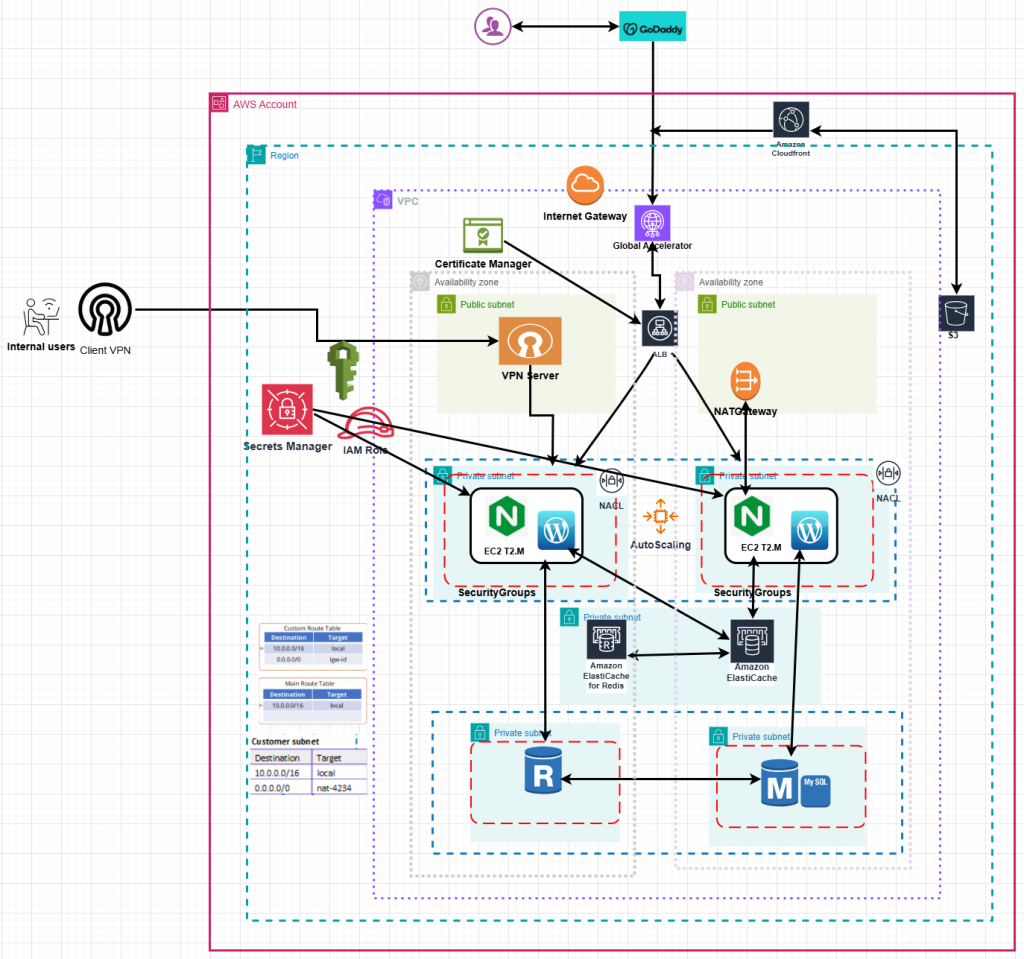MORU

Robust WordPress Architecture on AWS: A Comprehensive Solution
The architecture diagram illustrates a sophisticated, high-availability WordPress deployment on AWS that combines security, performance, and scalability. This setup represents a production-grade solution that addresses common challenges in WordPress hosting.
Architecture Overview
This implementation leverages multiple AWS services in a well-structured approach:
- Client Access Layer
- External users connect via Client VPN for secure administrative access
- Regular website visitors connect through CloudFront and internet gateways
- GoDaddy DNS integration for domain management
- Network Architecture
- Custom VPC with clear network segmentation
- Multiple availability zones for high availability
- Public and private subnets with appropriate security controls
- NAT Gateway for outbound connectivity from private resources
- Application Layer
- EC2 instances running WordPress in an auto-scaling configuration
- Load balancing through ALB (Application Load Balancer)
- VPN server for secure administrative access
- Data Layer
- MySQL database for WordPress content
- Amazon ElastiCache in two configurations:
- Redis for object caching
- Standard ElastiCache for page caching
- S3 for media storage and backups
- Security Components
- Certificate Manager for SSL/TLS
- Secrets Manager for credential management
- IAM roles for service-level permissions
- Security Groups and NACLs for network security
- VPN for secure administrative access
Key Benefits of This Architecture
High Availability
The deployment spans multiple availability zones with redundancy at each tier. The auto-scaling configuration ensures that the WordPress application can handle varying loads, while ElastiCache provides fast access to frequently requested content.
Performance Optimization
This architecture implements several performance enhancements:
- CloudFront CDN for global content delivery
- ElastiCache for Redis to reduce database load
- ElastiCache for page caching to improve response times
- Load balancing to distribute traffic efficiently
Security in Depth
Security is implemented at multiple levels:
- Network segmentation with public/private subnets
- Security Groups for instance-level firewall
- NACLs for subnet-level network controls
- VPN for secure administrative access
- Certificate Manager for encrypted connections
- Secrets Manager for secure credential storage
Scalability
The architecture is designed to scale effectively:
- Auto-scaling EC2 instances based on demand
- Separate database tier that can be scaled independently
- ElastiCache clusters that can grow as caching needs increase
- S3 for virtually unlimited media storage
Implementation Considerations
When implementing this architecture, several aspects require careful planning:
- WordPress Configuration
- The WordPress installations should be configured to use the ElastiCache Redis instance for object caching
- Media uploads should be configured to store files in S3 rather than locally
- Database connections should be optimized for the MySQL implementation
- Backup Strategy
- Database backups should be scheduled regularly
- WordPress configuration files should be version-controlled
- S3 lifecycle policies should be configured for media backups
- Security Maintenance
- SSL certificates need to be monitored for expiration
- Security Groups and NACLs should be regularly audited
- IAM roles should follow least privilege principles
- Performance Monitoring
- CloudWatch metrics should be set up to monitor EC2, ElastiCache, and database performance
- Custom alarms should be configured for key metrics
- Load testing should be performed to validate auto-scaling policies
Cost Optimization
This architecture provides several opportunities for cost optimization:
- Auto-scaling ensures you only pay for the compute resources you need
- Reserved Instances can be purchased for predictable workloads
- S3 storage classes can be leveraged for less frequently accessed media
- ElastiCache instance types can be adjusted based on actual caching needs
Conclusion
This AWS architecture for WordPress represents a thoughtfully designed solution that balances performance, security, and cost-effectiveness. By leveraging AWS managed services and implementing proven patterns for high availability, this deployment provides a robust foundation for WordPress sites of various sizes and complexity.
The clear separation of public and private resources, combined with multi-layer security controls, creates a secure environment for hosting WordPress while maintaining the flexibility to scale as traffic demands increase. This approach is particularly well-suited for business-critical WordPress implementations that require enterprise-grade reliability and performance.